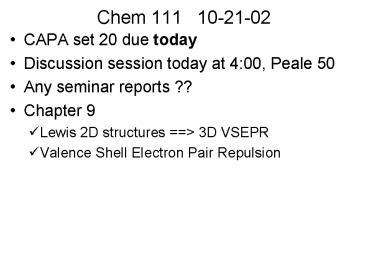Chem 111 102102 - PowerPoint PPT Presentation
1 / 22
Title:
Chem 111 102102
Description:
Release lattice energy by bringing ions together at distance d. Energetics ... For 3 domains, 120 == trigonal planar. For 4 domains, 109.5 == tetrahedral ... – PowerPoint PPT presentation
Number of Views:95
Avg rating:3.0/5.0
Title: Chem 111 102102
1
Chem 111 10-21-02
- CAPA set 20 due today
- Discussion session today at 400, Peale 50
- Any seminar reports ??
- Chapter 9
- Lewis 2D structures gt 3D VSEPR
- Valence Shell Electron Pair Repulsion
2
Release lattice energy by bringing ions together
at distance d
Energetics of ionic bond formation Born - Haber
cycle
411 kJ 108 kJ Na(g) 122 kJ
Cl(g) 496 kJ Nag) 349 kJ
Cl(g) ?Hlattice
?Hlattice 788 kJ is the energy to separate
NaCl(s) into gas phase ions
3
Another example
- Combustion of acetylene, C2H2
- C2H2(g) 5/2 O2(g) ? 2 CO2(g) H2O(g)
- Use Lewis structures to get bond types
- Hesss Law and bond enthalpy estimate ?Hrxn
- Breaking bonds requires energy
- Making bonds releases energy
- The energy difference is ?Hrxn
4
Bond Enthalpy 348 kJ/mol 614 kJ/mol 839 kJ/mol
Multiple bonds, more e density, shorter, stronger
5
Lewis structures
- Connections between atoms, bonding electrons
- Single, double or triple bonds
- Number of unshared, non-bonding electrons
- Drawn in two dimensions
- The real world is three dimensional
- The Lewis model helps to predict the shape of
many simple molecules
6
Some generic simple molecules
- Why generic ?
- Look for patterns !!
- Simple !!
- Single central atom with two to six bonded atoms
- Central atom is A (from the p block) and bonded
atoms are B - ABn where n is from 2 to 6
- H2O, CO2, NH3, SO3, CH4, CCl4, SF4
- Only five fundamental molecular geometries
7
AB2
AB3
8
AB4
AB5
9
AB6
- Eight faces w/equilateral triangles
- Six vertices
10
Why these, not other random shapes
- The behavior of the bonded and non-bonded
electron pairs gt referred to as electron domain - Electron domain
- Non-bonding pair located on a single atom
- Single bond shared between two atoms
- Multiple bond shared between two atoms
- The best arrangement for a given number of
electron domains minimizes repulsions - the
domains want to be far apart !! VSEPR
11
And these arrangements are
- For 2 domains, 180 gt linear
- For 3 domains, 120 gt trigonal planar
- For 4 domains, 109.5 gt tetrahedral
- For 5 domains, 120 90 gt Triganol
bipyramid - For 6 domains, 90 gt octahedral
- Same shapes as the ABn geometries
12
VSEPR and Lewis structure
- Use Lewis structure to get total electron domains
around central atom - Each non-bonding pair is a domain
- Each bond type (single, double or triple) is
counted as one domain
13
VSEPR and two types of geometry
- Electron domain geometry
- Arrange all electron domains around the central
atom to minimize repulsions - Molecular geometry
- Arrangement of only bonded atoms around the
central atom is used to determine the molecular
geometry - The exact molecular geometry is affected by the
non-bonding domains
14
The non-bonding pair takes up more space so that
it has a greater repulsion effect on bonded pairs
15
- The Effect of Nonbonding Electrons and Multiple
Bonds on Bond Angles - The larger non-bonding orbitals decrease the
expected bond angle - Multiple bonds with greater electron density have
a similar effect in that they take up more space
and have a greater repulsion
16
Geometries for expanded octets
- For 5 domains, 120 90 gt Triganol
bipyramid
Non-bonding pairs will always go in the
equatorial position because they see only two
domains at 90. In axial they would see three
domains at 90, which would increase repulsions.
17
Geometries for expanded octets
- For 5 domains, 120 90 gt Triganol
bipyramid - 4 bonding is seesaw
- 3 bonding is T-shaped
- 2 bonding is linear
- For 6 domains, 90 gt octahedral
- 5 bonding is square pyramid
- 4 bonding is square planar
18
Geometries for larger molecules
Triganonal planar
Tetrahedral
Bent
19
Molecular shape and polarity
- Each bond can be viewed as a dipole
- A vector quantity with magnitude and direction
- Molecule polarity is the sum of all the bond
vectors - Equal and opposite vectors cancel
- Symmetry around the central atom will lead to a
non-polar molecule, even if bonds are polar - Other vector combinations yield polar molecules
20
Molecular shape and polarity
21
Molecular shape and polarity
Net polarity for the molecule
22
Polar
Polar
Polar
Non-polar
Non-polar































